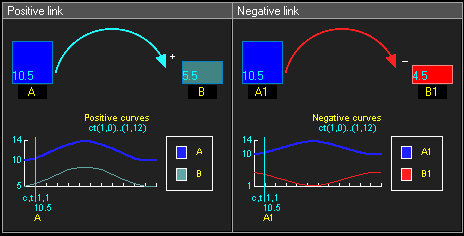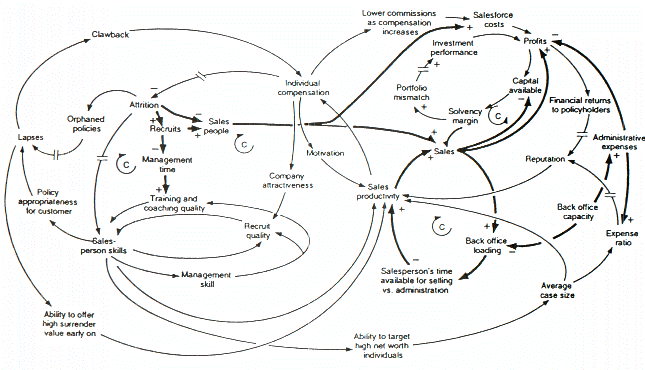Causal loop diagram

A causal loop diagram (CLD) is a diagram that aids in visualizing how interrelated variables affect one another. The diagram consists of a set of nodes representing the variables connected together. The relationships between these variables, represented by arrows, can be labelled as positive or negative.
Example of positive reinforcing loop:
The amount of the Bank balance will affect the amount of the Earned interest, as represented by the top blue arrow, pointing from Bank Balance to Earned interest.
Since an increase in Bank balance results in an increase in Earned interest, this link is positive, which can be denoted with a ""+"".
The Earned interest gets added to the Bank balance, also a positive link, represented by the bottom blue arrow.
The causal effect between these nodes forms a positive reinforcing loop, represented by the green arrow, which can be denoted with a ""R"".
Positive and negative causal links
- Positive causal link mean that the two nodes move in the same direction, i.e. if the node in which the link starts decreases, the other node also decreases. Similarly, if the node in which the link starts increases, the other node increases.
- Negative causal link is link in which the nodes change in opposite directions: an increase causes a decrease in another node, or a decrease causes an increase in another node.
Example

Reinforcing and balancing loops
To determine if a causal loop is reinforcing or balancing, one can start with an assumption, e.g. "Node 1 increases" and follow the loop around, the loop is:
- reinforcing if one, after going around the loop, ends up with the same result as the initial assumption,
- balancing if the result contradicts the initial assumption.
Or to put it in other words:
- reinforcing loops have an even number of negative links (zero also is even, see example above)
- balancing loops have an uneven number of negative links.
Identifying reinforcing and balancing loops is an important step for identifying Reference Behaviour Patterns, i.e. possible dynamic behaviours of the system.
- A reinforcing loop is associated with an exponential increase/decrease.
- Balancing loops are associated with reaching a plateau.
If the system has delays (often denoted by drawing a short line across the causal link), the system might fluctuate.
Example


See also
External links
- System Models & Simulation - Shows a causal-loop diagram of a dynamic system that is parameterized with data and equations, then simulated and graphed.
- WikiSD the System Dynamics Society Wiki
